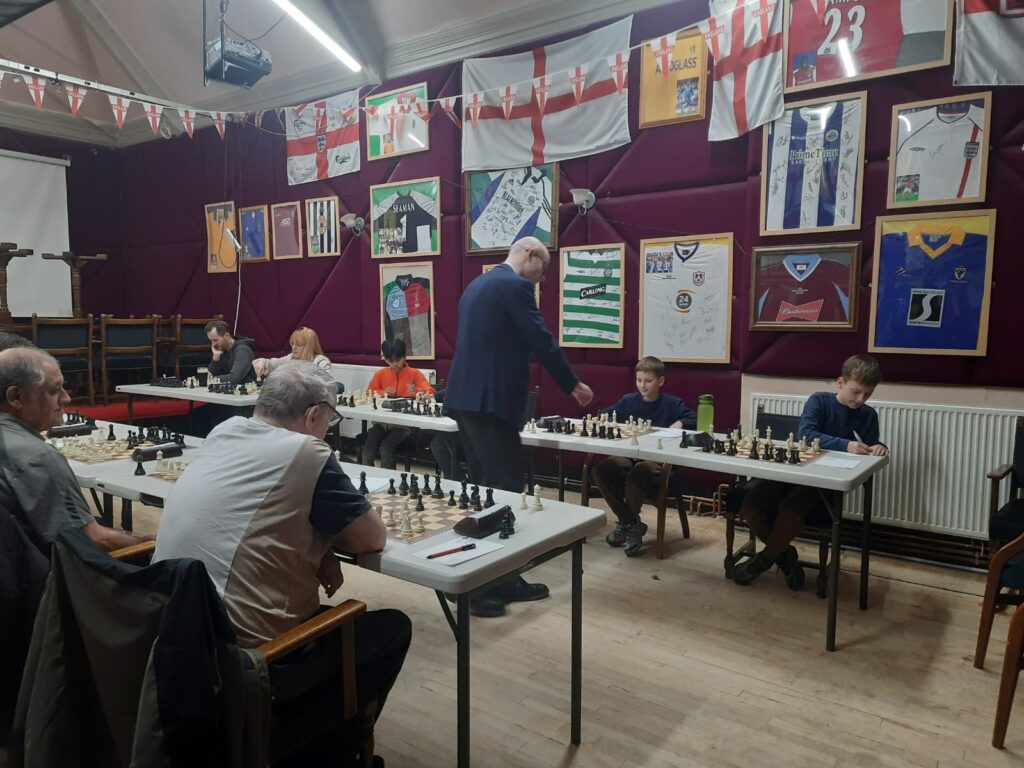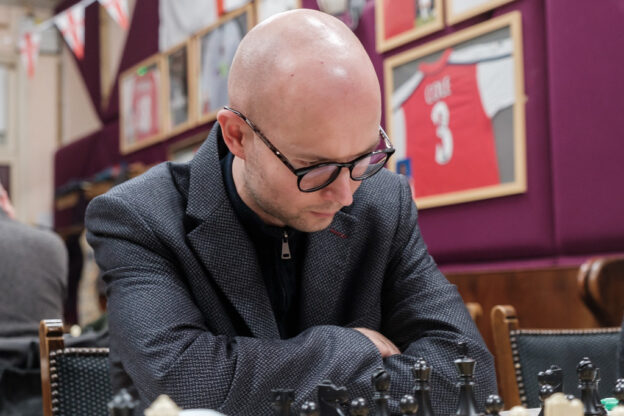Peter Lalić says the key to doing well when you give a simul is to bore your opponents to defeat. Here he explains how he approached one he gave recently at Kingston
As part of Kingston’s Summer Programme, a number of our strongest players have kindly consented to give simultaneous displays (“simuls” in chess parlance). First up was IM Ameet Ghasi, who annihilated all-comers, helped by what he felt was an overly generous time differential. For the second simul, given by CM Peter Lalić (pictured above), the clock settings were adjusted and the play was a little less one-sided.
Peter had an hour and a quarter with no increment; his 15 opponents had 20 minutes with a 10-second increment. Peter eventually emerged triumphant, with 14 wins, a single draw and no losses. But there were a few hiccups along the way: Peter only realised late on that he had no increment and had to start running between the three or four boards where his time was in danger of running out.
Several games were won with seconds to spare on his clock. He conceded a draw to Kingston stalwart Ed Mospan, which was a source of great satisfaction – to Ed and the rest of us, if not to Peter. Ed was ecstatic and punched the air in delight, saying he would frame the scoresheet. Peter has an ECF rating close to 2300. Ed’s is more than 700 points lower, so this was a significant achievement.
It is the nice point about simuls that players who do well remember their games forever. I was in touch recently with a 67-year-old club player now retired from over-the-board chess. He sent me a game he had played almost 50 years ago against Britain’s first GM, Tony Miles. My correspondent hadn’t won or even drawn the game, but he had played well and Miles had congratulated him. That memory burned bright half a century later.
Peter takes such exhibitions very seriously and, to my surprise, said afterwards that he was “more proud of this performance than of any of my classical games, especially because I played with the black pieces and had no increment”. I asked him to explain why it mattered so much to him. “I thought I had an increment, but I was watching one of the kids and when I watched the clock I panicked because I realised I didn’t have an increment and all of a sudden I thought ‘I can lose half of these on time’. I had only minutes left on some of them., and when I managed to be unbeaten it was a great relief.”
Peter had opted to play Black in all the games, and says his strategy was to bore his opponents to defeat. He played 1…d6 in all games, regardless of White’s opening move, and says that he was generally able to control the pawn structure which ensued. Eighty per cent of the games had the pawn structure shown in the first diagram below; a third of the games had the structure shown in the second diagram, with queens exchanged (a Lalić speciality); in a third of the games White advanced a pawn to d5 (diagram 3), and in a fifth of the games Black was able to construct the pawn chain shown in diagram 4.




“I was able to race around the room on the opening moves because I was playing the same thing,” Peter explains. “They are the equivalent of pre-moves. Even after five moves, 33 per cent of my games had the same position (see diagram 2 above). It’s the Lalić system! I’m sure that if I’d played anything that was less systematic I would have dropped a couple of losses. It could even have been worse than that because if you have a couple of difficult games there can be a domino effect. I could easily have scored only 60 per cent with a different opening. It’s the fact that the games are so boring that excites me!”

Peter says calculation is difficult in a simul and it’s easy to lose the thread of a game. He had asked his opponents to keep score and says he sometimes had to remind himself what had been played by sneaking a look at their scoresheets – and this is a player with a phenomenal memory! “That’s why I had to play on autopilot,” he says. “I wanted to avoid chaos, and my study of these opening structures and my ability to force my opponents on to my territory meant I had virtually no chaos.”
He says the only player who brought him close to the anarchy he was seeking to avoid was John Bussmann, as shown in the game below. ” It’s no coincidence that he, being the most highly rated player, was the only one to create chaos,” says Peter. “He knew good simul technique and shows what a challenger should do.”
Ed Mospan was justifiably proud of the game he played against Peter and deserves his framed scoresheet:
Peter notes the two players’ accuracy in this game was down at 91 per cent. In the game against Emma Buckley, his accuracy level was 99 per cent! Emma’s accuracy level was a more than creditable 93 per cent, she battled on for 64 moves, and in the course of the game set this nice trap:
Emma played 25. c5 here, which appears to invite Kc3. The latter would lose the knight to b4 – easy to overlook in a simul. Peter dodged the bullet and went on to win the endgame. Emma is Peter’s half-sister, which made the competition all the more intense; on move 22 she told Peter the position was “dead drawn” – familial trash talking!
Generally Peter’s “boring is beautiful” strategy worked. “I tried to make sure there was nothing going on,” he says, “and the games hinged on one or two static weaknesses in my opponents’ positions.” This is often what happens in simuls: the master-level player isn’t necessarily looking to blow you away over the board, but instead to gain a technical advantage and then squeeze. So when you’re next facing a superstar in a simul, be ready to trade blows and create as much chaos as possible. Even if you lose you will have a lot of fun and, who knows, you might even win.
Peter makes the point that Dutch grandmaster and acclaimed writer and aphorist Jan Hein Donner was on to this more than half a century ago. “Play aggressively,” Donner advised. “Ninety-five percent of all victims in simultaneous displays usually owe their defeat to their own passivity. The simul-giver lacks the time to work out variations, but doing so is more important when defending than in an attack. On psychological grounds, too, aggressively approaching the simul-giver is a sound and very effective strategy.”
Peter is now looking forward to the simuls which will be given at Kingston by his friends and team-mates Vladimir Li and David Maycock in the next month. It would surely be too cynical to suggest that he is offering this advice to their potential opponents in order to make life harder for them. Peter just doesn’t think in that Gore Vidal-type way. (Vidal’s famous quip was “It is not enough to succeed. Others must fail.”) At Kingston we value togetherness, and such oneupmanship simply doesn’t enter our leading players’ calculations. At least I don’t think it does….
Stephen Moss, club captain, Kingston Chess Club

